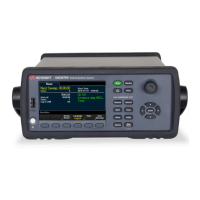[SENSe:]{RESistance|FRESistance}:APERture {<seconds> | MIN | MAX | DEF} [, (@<ch_list>)]
[SENSe:]{RESistance|FRESistance}:APERture? [{(@<ch_list>) | MIN | MAX | DEF}]
Enables the aperture mode and sets the integration time in seconds (called aperture time) for 2-wire and 4-wire res-
istance measurements.
Used this command for precise control for the DMM's integration time.Use NPLC for better power-line noise
rejection characteristics (NPLC >1) (see [SENSe:]{RESistance|FRESistance}:NPLC command).
Parameter is shared between RESistance and FRESistance measurements. Setting or querying the parameter
with the RESistance version of this command is identical to setting or querying it with the FRESistance ver-
sion.
Parameter Typical return
200 μs to 1 s (2 μs resolution). Default: 100 ms +1.00000000E- 01
Enable aperture time mode, set the aperture time to 300 ms:
RES:APER:ENAB ON
RES:APER 300E-03
or
FRES:APER:ENAB ON
FRES:APER 300E-03
– For 4-wire resistance measurements, the instrument automatically pairs channel n in Bank 1 with channel n+10
in Bank 2 (DAQM900A or DAQM901A) or n+8 (DAQM902A) to provide the source and sense connections. For
example, make the source connections to the HI and LO terminals on channel 02 in Bank 1 and the sense con-
nections to the HI and LO terminals on channel 12 (DAQM900Aor DAQM901A) or 10 (DAQM902A) in Bank
2.Specify the paired channel in Bank 1 (source) as the <ch_list> channel (paired channels in Bank 2 are not
allowed in the <ch_list>).
– Only the integral number of power line cycles (1, 2, 10, 20, 100, or 200 PLCs) provide normal mode (line fre-
quency noise) rejection.
– The CONFigure:{RESistance|FRESistance}, MEASure:{RESistance|FRESistance}, [SENSe:]
{RESistance|FRESistance}:NPLCycles, and [SENSe:]{RESistance|FRESistance}:RESolution commands disable
the aperture mode (these commands select an integration time in number of power line cycles).
– This parameter is set to its default value after a Factory Reset (*RST command).
240
Keysight DAQ970A/DAQ973A Programming Guide
2 SCPI Programming

